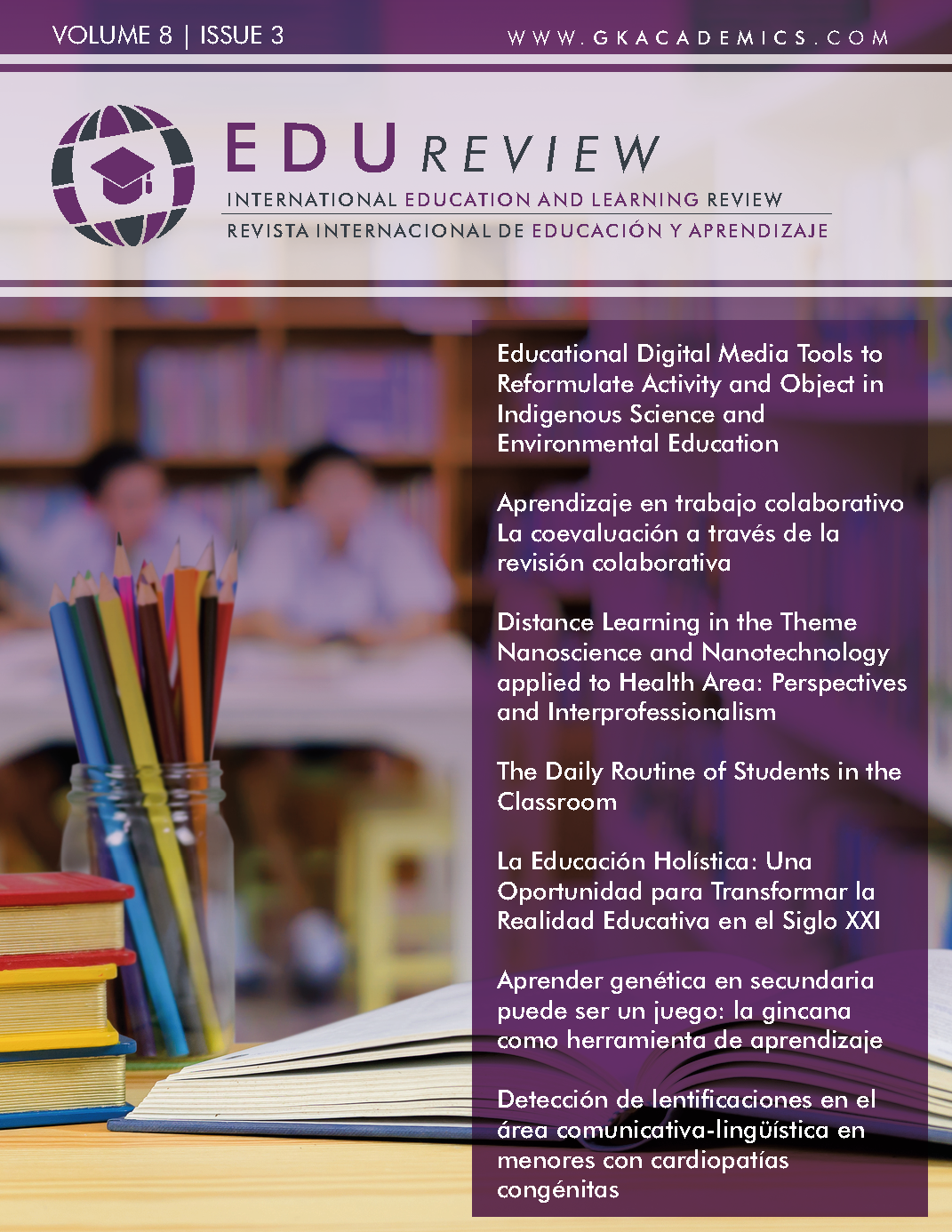Educational Digital Media Tools to Reformulate Activity and Object in Indigenous Science and Environmental Education
DOI:
https://doi.org/10.37467/gka-revedu.v8.2666Palabras clave:
Indigenous Digital Storytelling, Indigenous Science and Environmental Education, Indigenous Community Science EducationResumen
This paper examines the functioning of and underlying assumptions about digital media in collaborative curriculum design processes in public science and environmental education, and community-designed action research learning programs. The article discusses teaching practices in US rural Northeast Wisconsin among Native Youth learning processes, from the complementation and articulation of formal and informal education to meaningful engagement and participation in science. The focus on the transformative use of digital media in science community education is intended to serve two interrelated purposes: First, it helps to address cultural-historical relations around the production of knowledge and relevant curriculums and pedagogies for rural tribal youth. Second, it intersects with the opportunities for the transferability of activity systems and action research centered around the production of mediational artifacts designed for the collective negotiation between First Nations Tribal communities and western modeled schools, institutions, workplaces, and societal roles. The transferability of this model envisions the incorporation of local actors and institutions in a deep artifact-based dialogue around epistemologies of self-determination and sustainability for Peoples who are fighting for their survival. These propositions take a new level when the transformative power of digital media shifts representations of power in historically marginalized communities, serving a larger activity of reorganizing ecologies of learning in education for culturally distinctive communities of practice.
Descargas
Estadísticas globales ℹ️
|
512
Visualizaciones
|
272
Descargas
|
|
784
Total
|
|
Citas
Angen, M. J. (2000). Evaluating interpretive inquiry: Reviewing the validity debate and opening the dialogue. Qualitative health research, 10(3), 378-395. DOI: https://doi.org/10.1177/104973200129118516
Barab, S. A., & Plucker, J. A. (2002). Smart people or smart contexts? Cognition, ability, and talent development in an age of situated approaches to knowing and learning. Educational Psychologist, 37(3), 165-182. DOI: https://doi.org/10.1207/S15326985EP3703_3
Roth, W. M., & Lee, Y. J. (2007). “Vygotsky’s neglected legacy”: Cultural historical activity theory. Review of Educational Research, 77(2), 186-232. DOI: https://doi.org/10.3102/0034654306298273
Engeström, Y. (1991). Non-scolae sed vitae discimus: Toward overcoming the encapsulation of school learning. Learning and instruction, 1(3), 243-259. DOI: https://doi.org/10.1016/0959-4752(91)90006-T
Engeström, Y., & Sannino, A. (2010). Studies of expansive learning: Foundations, findings and future challenges. Educational Research Review, 5(1), 1-24. DOI: https://doi.org/10.1016/j.edurev.2009.12.002
Smith, L. T. (1999). Decolonizing methodologies: Research and indigenous peoples. Zed books.
Bang, M., Medin, D., Washinawatok, K., & Chapman, S. (2010). Innovations in culturally based science education through partnerships and community. In M. S. Khine, & I. M. Saleh (Eds.), New science of learning (pp. 569-592). New York: Springer. DOI: https://doi.org/10.1007/978-1-4419-5716-0_28
Bang, M., Medin, D. L., & Atran, S. (2007). Cultural mosaics and mental models of nature. Proceedings of the National Academy of Sciences, 104(35), 13868-13874. DOI: https://doi.org/10.1073/pnas.0706627104
Wilson (Waziyatawin), W. A., & Yellowbird, M., (Eds.). (2007). For indigenous eyes only: A decolonization handbook. Santa Fe, NM: School of American Research Press.
LaFrance, J., & Nichols, R. (2009). Indigenous evaluation framework: Telling our story in our place and time. Alexandria, VA: American Indian Higher Education Consortium & National Science Foundation.
Gutiérrez, K. D., & Rogoff, B. (2003). Cultural ways of learning: Individual traits or repertoires of practice. Educational researcher, 32(5), 19-25. DOI: https://doi.org/10.3102/0013189X032005019
Engeström, Y., Engeström, R., & Suntio, A. (2002). Can a school community learn to manage its own future? An activity-theoretical study of expansive learning among middle school teachers. In G. Wells &G. Claxton (eds.), Learning for life in the 21st century: Sociocultural perspectives on the future of education (pp. 211-224). London: Blackwell. DOI: https://doi.org/10.1002/9780470753545.ch16
Engeström, Y. (1999). Activity theory and individual and social transformation. In Y. Engeström, R. Miettinen, & R-. Punamäki (eds.), Perspectives on activity theory (pp. 19-38). New York: Cambridge University Press. DOI: https://doi.org/10.1017/CBO9780511812774.003
Engestrom, Y. (2000). Activity theory as a framework for analyzing and redesigning work. Ergonomics, 43(7), 960-974. DOI: https://doi.org/10.1080/001401300409143
Engeström, Y. (2004). New forms of learning in co-configuration work. Journal of Workplace Learning, 16(1/2), 11-21. DOI: https://doi.org/10.1108/13665620410521477
Engeström, Y., & Hasu, M. (2000). Measurement in action: an activity-theoretical perspective on producer–user interaction. International Journal of Human-Computer Studies, 53(1), 61-89. DOI: https://doi.org/10.1006/ijhc.2000.0375
Tomasello, M. (1999). The human adaptation for culture. Annual Review of Anthropology, 28, 509-529. DOI: https://doi.org/10.1146/annurev.anthro.28.1.509
Gutiérrez, K., & Vossoughi, S. (2010). Lifting off the ground to return anew”: Documenting and designing for equity and transformation through social design experiments. Journal of Teacher Education, 61(1-2), 100-117. DOI: https://doi.org/10.1177/0022487109347877
Ladson-Billings, G. (Ed.). (2003). Critical race theory perspectives on the social studies: The profession, policies, and curriculum. Charlotte, NC: Information Age Publishing.
Descargas
Publicado
Cómo citar
Número
Sección
Licencia
Los autores/as que publiquen en esta revista aceptan las siguientes condiciones:
- Los autores/as conservan los derechos de autor.
- Los autores/as ceden a la revista el derecho de la primera publicación. La revista también posee los derechos de edición.
- Todos los contenidos publicados se regulan mediante una Licencia Atribución/Reconocimiento-SinDerivados 4.0 Internacional. Acceda a la versión informativa y texto legal de la licencia. En virtud de ello, se permite a terceros utilizar lo publicado siempre que mencionen la autoría del trabajo y a la primera publicación en esta revista. Si transforma el material, no podrá distribuir el trabajo modificado.
- Los autores/as pueden realizar otros acuerdos contractuales independientes y adicionales para la distribución no exclusiva de la versión del artículo publicado en esta revista (p. ej., incluirlo en un repositorio institucional o publicarlo en un libro) siempre que indiquen claramente que el trabajo se publicó por primera vez en esta revista.
- Se permite y recomienda a los autores/as a publicar su trabajo en Internet (por ejemplo en páginas institucionales o personales), una vez publicado en la revista y citando a la misma ya que puede conducir a intercambios productivos y a una mayor y más rápida difusión del trabajo publicado (vea The Effect of Open Access).













